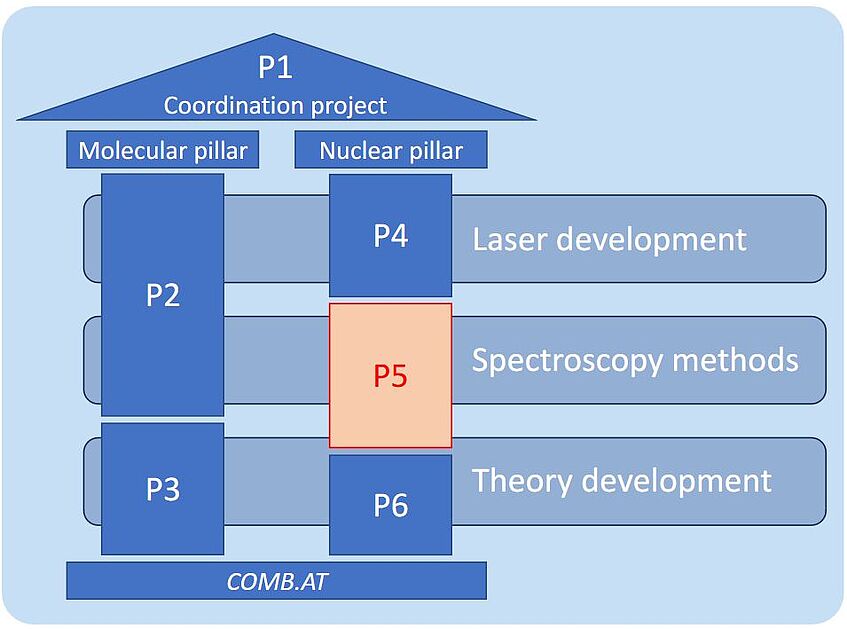P5 229Th nuclear spectroscospy in solid-state

P5 229Th nuclear spectroscospy in solid-state
The 8 eV nuclear transition of the Thorium-229 nucleus presents an exciting and unique system for precision laser spectroscopy. A multitude of fundamental investigations and practical applications have been suggested, ranging from searches for physics beyond the standard model to the construction of an optical nuclear clock.
Prerequisite for these prospects is the ability to (coherently) manipulate the nuclear 2-level system with laser light, which so-far has remained elusive due to two main challenges:
- The transition wavelength is 148,7(4) nm in the vacuum ultraviolet regime, where no conventional laser spectroscopy sources are available.
- The nuclear transition is dipole-forbidden (M1 and weak E2), reducing the interaction cross section with light and hence the nuclear excitation probability by many orders of magnitudes compared to typical electron shell transitions. A narrow linewidth (order millihertz for a bare nucleus) and corresponding lifetime of hundreds of seconds makes absorption or fluorescence laser spectroscopy a formidable challenge.
In this project our team aims to overcome these challenges and realize laser spectroscopy of the 229Th nuclear transition by combining a solid-state crystal sample approach with a tailormade pulse train VUV laser system.
By doping 229Th into VUV transparent crystal matrices, the number of laser-interrogated nuclei can be pushed into the >1015 range. Even more important for this project, the thorium-crystal interaction leads to the emergence of additional quantum levels, both, in the nuclear (quadrupole structure) and the electronic (defect/colour centres) degrees of freedom. The key innovative aspect of this subproject is to exploit these additional quantum states to enhance the nuclear excitation probability or detection sensitivity by several orders of magnitudes.
Team of P5
The sub-project P5 “229Th nuclear spectroscopy in solid-state” is led by Thorsten Schumm at the Institute of Atomic and Subatomic Physics of TU Wien. He can be considered as one of the leading figures in the applications of the 229Th nuclear transition, having initiated the most comprehensive research networks on the topic.
The experiments concerning the excitation of the 229Th isomer will take place at TU Wien. Sample production, fabrication, and characterization of detection chambers will take place at the Institute for Atomic and Subatomic Physics (site of P5), laser development and excitation of the sample will take place at the Photonics Institute (site of P4).
The project team currently consists of 2 permanent staff scientists working in VUV laser development, 1 lab technician focusing on crystal growth, characterization and processing, 2 administrative staff scientist supporting in project administration and training/outreach activities, as well as electronics and mechanical workshops. We are closely collaborating with the team of Andreas Grüneis (Prof.) and Martin Pimon (PostDoc) which perform density functional theory (DFT) simulations for the doped crystals.
Thanks to the SFB COMB.AT, 2 PhD students could join the team. One of them will focus on in house crystal sample development for the spectroscopy samples. Together with the lab technician (A. Leitner) and the DFT theory team (M. Pimon, A. Grüneis), the PhD student will identify the most promising host materials, develop fabrication processes, and characterize the obtained samples for optical and radiological properties. In particular, the presence and exact energy of defect centers is of utmost relevance and already represents an important scientific result.
The other PhD student will focus on the 229Th Isomer detection using Fluorescence detection and NQRS. Once the optimal host material(s) is/are selected, the detection schemes need to be adapted. In the case of optical detection, background rejection schemes need to be tailored to the material properties. In the case of NQR detection, the NQR splittings are exclusively caused by the local electric field gradient produced by the host material (at the nucleus position). These need to be calculated, and then the NQR electronics need to be adapted for the highest sensitivity in the expected wavelength regime.
